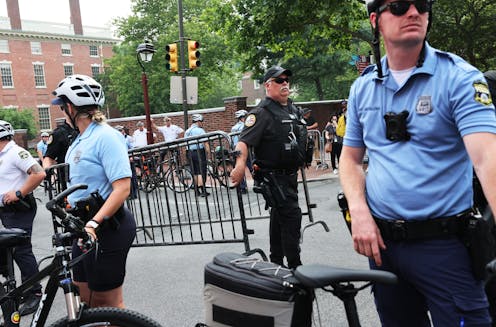
After weeks of public pressure, Philadelphia police on Sept. 8, 2023, released body camera footage capturing the fatal shooting of 27-year-old Eddie Irizarry by police in August.
The Conversation spoke to Jordan M. Hyatt, associate professor of criminology and justice studies and the director of the Center for Public Policy at Philadelphia’s Drexel University, to explain the rules controlling when the public gets to see body cam footage – and how Philadelphia’s legal framework compares to other places in the U.S.
How long have Philadelphia police been using body cams?
The department began using what are more formally known as “body-worn cameras” as part of a pilot program in 2014 – about seven years after the cameras first became available in the U.K. However, their use in Philadelphia did not become widespread until 2017. Even now, only about 68% of all officers wear one, according to numbers provided by the Philadelphia police.
Who decides when this video is made public?
The district attorney’s office has the final say regarding any video release while there is an active, potentially criminal investigation. Officer Mark Dial surrendered to police on Sept. 8 and faces murder and other charges in the shooting. Earlier, the police commissioner had indicated her intent to fire him for insubordination after a 30-day suspension.
Videos of police encounters with the public are not considered public records at the state level. A change in Pennsylvania law passed in 2017 prevents the release of these recordings under right-to-know processes.
In deciding to release footage, the Philadelphia police and district attorney try to balance state and federal rules with the wishes of the victim and their family, the need to preserve the integrity of videos as evidence in a criminal trial, ongoing investigations and public safety concerns.
Can a resident of Philadelphia ask for video to be released?
Yes, but the process can be slow and is rarely successful. A detailed request must be submitted within 60 days of the incident either in person or by certified mail. The requesting party must also pay the costs associated with the request.
State laws and local regulations require the law enforcement agency to first decide if a video can be released and provide an explanation for any denial. Decisions can be appealed to the Court of Common Pleas – a judicial process that can take quite some additional time.
That is not to say that body camera footage is never released, but it is exceedingly uncommon across Pennsylvania. The Irizarry video is only the second such video released in Philadelphia.
The first video released showed the police-shooting death of Walter Wallace Jr. in 2020. That video also came out after an intense public outcry.
Why has the Irizarry case drawn so much attention?
Initially, the Philadelphia police declined to release the Irizarry footage, citing the ongoing investigation. And, at first, District Attorney Larry Krasner agreed to withhold it.

But a home security system also captured video of the incident, and the homeowner released it to the Irizarry family’s attorney about a week after the shooting. It seems to show Dial opening fire almost immediately after arriving at the scene.
Shortly after this third-party video came out, and amid increasingly visible protests, Krasner allowed Irizarry’s family to view the official footage and promised to release it to the public. On Sept. 8, Krasner made good on that promise.
Is Philadelphia’s record for releasing footage unusual?
The approach in both Philadelphia and Pennsylvania is fairly common.
A 2018 survey by the Police Executive Research Forum found that 17% of police departments never release videos. Like Philadelphia, nearly 80% can withhold them if they will be used as evidence or in a personnel matter.
Philadelphia’s approach is broadly similar to other large cities, including New York and Washington, D.C. Unlike jurisdictions in Pennsylvania, however, these cities allow for the online submission of requests to view video footage under relevant open records laws, potentially speeding up the process.
Why don’t all of the city’s police wear body cameras?
The program is widespread; however, cameras have not yet been issued to the 15th district, highway, traffic, airport, narcotics strike force, neighborhood services and SWAT teams, according to the police department. Additionally, cameras are worn only by uniformed officers; undercover officers, for example, are exempt.
One of the biggest limitations to the adoption of body cameras nationwide has been the cost, which includes training, equipment and data storage. In Philadelphia, the program has cost US$20 million over the past decade, according to Axios.
Despite the large price tag, some research suggests that every $1 spent on body-worn cameras results in about $5 of savings by cutting down on complaints, including those that lead to lawsuits from citizens.
Zooming out, the use of body cameras has become commonplace in the U.S., with 80% of large police departments adopting their use by 2018. While the associated costs are a significant hurdle, especially for smaller municipalities, federal support has increased.
Advocates hoped body cameras would reduce violence by creating more transparency about police interactions with the public. Have they had that effect?
A review of all the rigorous, available research on the topic in 2020 found that body-worn cameras were associated with decreases in the number of citizen complaints and an increase in the quality of criminal investigations. Research findings on the effects on the use of force, arrests and assaults are more mixed, making drawing broad conclusions difficult.
In Philadelphia, recent studies suggest that body cameras can reframe the role of police, emphasizing their position as community guardians. Additional, high-quality research suggests that Philadelphia police officers wearing cameras had about 38% less use-of-force incidents and made 39% fewer arrests compared to officers not wearing cameras. Earlier studies in the city, however, found that body cameras had no effect on arrest rates or compliance but did reduce complaints.
It remains an open question whether opening up public access to the video captured by these cameras would increase positive outcomes.
Editor’s note: This story was updated to reflect the release of the video and charges brought against Officer Mark Dial.
Jordan Hyatt does not work for, consult, own shares in or receive funding from any company or organization that would benefit from this article, and has disclosed no relevant affiliations beyond their academic appointment.
This article was originally published on The Conversation. Read the original article.







